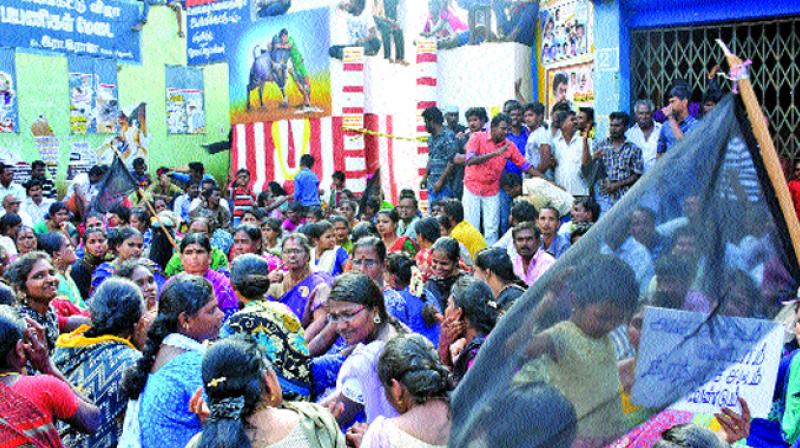Protests metaphorical fight for greater Tamil cause
There may be no logical explanation for the agitation against the ban on bull-taming to become a mass movement.

The jallikattu bulls ran again. The age-old tradition was restored after concerted executive action followed the popular uprising whose widening contours have defied belief. The bulls of Alanganallur, one of three ancient venues around Madurai, did not take off from the Vaadivasal as the students stuck to their stand not to permit politicians to hijack their protest. But, someday soon, the bulls of Alnaganallur, Palamedu and Avaniyapuram will also run and the agitators would have made their point.
There may be no logical explanation for the agitation against the ban on bull-taming to become a mass movement. Not even all the claims of social media connectivity could have led to so many being convinced of the cause of allowing a sport or pastime to continue. There was spontaneity to the protests for a rural sport spreading to the city. Not even an unresponsive Establishment of which, as Donald Trump rightly said, is more prone to talk rather than act, could deny a movement engendered by circumstance.
The one remarkable feature of the protests that have gone on since the start of the Pongal season is the politicians have been kept out. They were not allowed to take credit for what has been a mass movement by the Tamils who have been given the impression in recent events that no concern of theirs is worthy of being acted upon positively, be it river water and consequent farmer death and suicides, drought relief the fishermen’s issue and myriad others. Jallikattu became a symbol of the oppressed finding their voice. This is not only about the sport being denied on the count of cruelty to animals, about which the top court was convinced. The protest has become a metaphor for a more wholesome Tamil cause and for the restoration of Tamil pride.
The sanctity of laws and their interpretation even by the top court must seem somewhat dubious considering what has happened in the Cauvery case in which the formation of the CMB was ordered by the Supreme Court and yet there has been no executive action to follow through with it. Against the scenario of the dams of Karnataka and Maharashtra filled nearly to capacity while the states of Telangana, Andhra Pradesh and Tamil Nadu seek their rightful share in a distress year, it becomes somewhat difficult to argue about federalism to youth whose straightforward views of the truth is rather more pristine than the coloured versions career politicians believe in.
The whole issue may seem silly when considering there are more weighty issues that must concern us than the avowed cruelty to animals, of which we see so much more than we can hope to legislate against or police. The running bulls seem innocent enough when you seem them tearing away from human tormentors except that we know what barbaric tactics are unleashed on the animals to make a basically docile creature react thus. Also, there is the tragedy of human deaths, mostly of young participants, to contend with. A couple of them succumbed on Sunday too.
The irony is we can look at the beauty of the running bull and admire its athletic action in an aesthetic sense. We admire too the beauty of the Lipizzan horses when they demonstrate their ‘haute ecole’ movements, into which they have been trained for hundreds of years. But then, training methods impose such cruelty on them with trainers doing everything but put a cattle prod up their backsides. Racehorses run to the rush of adrenaline, to the promptings of jockeys, even very hard whipping in the straight at the business end of the race. Cruelty is often involved in the training of horses too. But do we ban the sport because some thoroughbreds are made to suffer when their skills are being honed? The sheer majesty of the movement of the thoroughbred trumps every other consideration.
It is somewhat simplistic to say jallikattu is a rural issue. It is a rural sport, yes, of which the understanding is less in the cities. Not anymore, not after the capital was made aware of the issue of the denial of local culture by the biggest mass movement seen in the state. Not even the anti-Hindi agitation of the mid 1960s by students was anywhere near this scale. The feeling that Tamil identity had been slighted was immense this time. To fight for an ancient rite in these modern times may seem incongruous, but we have to see the bull in its rural lair at a micro level to be able to empathise with what is happening even as students have come to the Marina beach in droves.
There is no need to give up the trappings of an older culture in the name of globalism. If a place has been found for local sport like kabaddi on television, why should not jallikattu be refined into a modern pastime in which there is no loss of lives of animals and human beings. As societies evolve, so do sports. We should be modern enough to make a safe jallikattu to satisfy the cultural instincts. This is not a matter of bowing to popular rage as much as understanding the reason for the anger. A safe jallikattu is not rocket science. We just have to put our minds to it. Also, it’s time the protests were called off as the Assembly will soon pass a law too, which in due course would have to stand legal scrutiny. Let the bulls run, but safely please.

